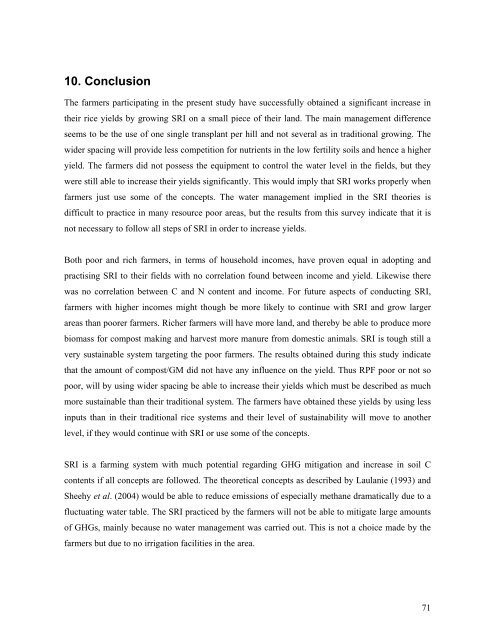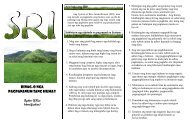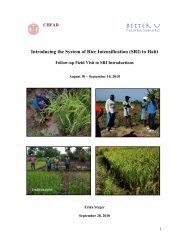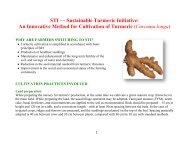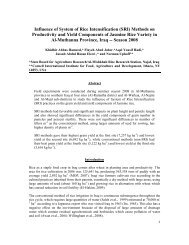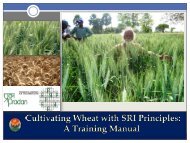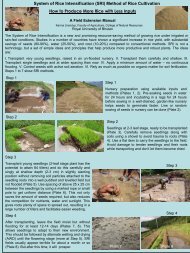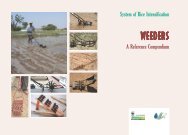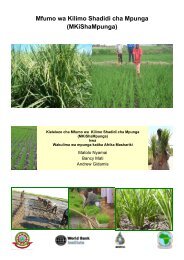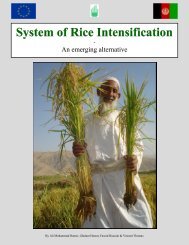EFFECT OF THE SYSTEM OF RICE INTENSIFICATION (SRI) ON ...
EFFECT OF THE SYSTEM OF RICE INTENSIFICATION (SRI) ON ...
EFFECT OF THE SYSTEM OF RICE INTENSIFICATION (SRI) ON ...
Create successful ePaper yourself
Turn your PDF publications into a flip-book with our unique Google optimized e-Paper software.
10. Conclusion<br />
The farmers participating in the present study have successfully obtained a significant increase in<br />
their rice yields by growing <strong>SRI</strong> on a small piece of their land. The main management difference<br />
seems to be the use of one single transplant per hill and not several as in traditional growing. The<br />
wider spacing will provide less competition for nutrients in the low fertility soils and hence a higher<br />
yield. The farmers did not possess the equipment to control the water level in the fields, but they<br />
were still able to increase their yields significantly. This would imply that <strong>SRI</strong> works properly when<br />
farmers just use some of the concepts. The water management implied in the <strong>SRI</strong> theories is<br />
difficult to practice in many resource poor areas, but the results from this survey indicate that it is<br />
not necessary to follow all steps of <strong>SRI</strong> in order to increase yields.<br />
Both poor and rich farmers, in terms of household incomes, have proven equal in adopting and<br />
practising <strong>SRI</strong> to their fields with no correlation found between income and yield. Likewise there<br />
was no correlation between C and N content and income. For future aspects of conducting <strong>SRI</strong>,<br />
farmers with higher incomes might though be more likely to continue with <strong>SRI</strong> and grow larger<br />
areas than poorer farmers. Richer farmers will have more land, and thereby be able to produce more<br />
biomass for compost making and harvest more manure from domestic animals. <strong>SRI</strong> is tough still a<br />
very sustainable system targeting the poor farmers. The results obtained during this study indicate<br />
that the amount of compost/GM did not have any influence on the yield. Thus RPF poor or not so<br />
poor, will by using wider spacing be able to increase their yields which must be described as much<br />
more sustainable than their traditional system. The farmers have obtained these yields by using less<br />
inputs than in their traditional rice systems and their level of sustainability will move to another<br />
level, if they would continue with <strong>SRI</strong> or use some of the concepts.<br />
<strong>SRI</strong> is a farming system with much potential regarding GHG mitigation and increase in soil C<br />
contents if all concepts are followed. The theoretical concepts as described by Laulanie (1993) and<br />
Sheehy et al. (2004) would be able to reduce emissions of especially methane dramatically due to a<br />
fluctuating water table. The <strong>SRI</strong> practiced by the farmers will not be able to mitigate large amounts<br />
of GHGs, mainly because no water management was carried out. This is not a choice made by the<br />
farmers but due to no irrigation facilities in the area.<br />
71


